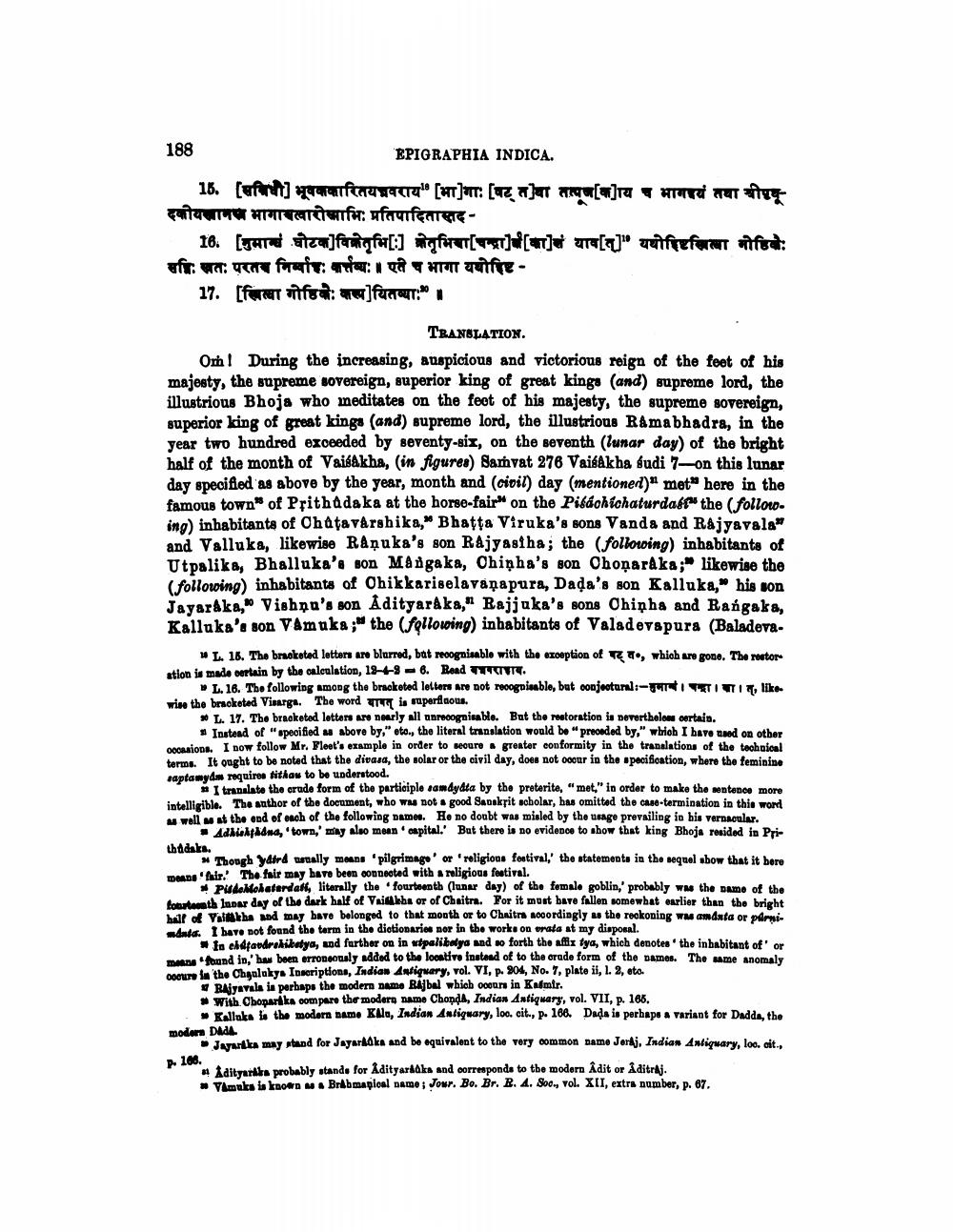________________
188
EPIGRAPHIA INDICA.
18. (afrit q fcrecer [HT]: [arz] [E]Tata दकीयतामण भागाचत्वारोबाभिः प्रतिपादितास्तद
18. (Tre sca] forangfa[:] aqfet [1]u ur[c]" defeferat afta: eft w aar foraft: arta HTIT aufre
17. [funt ifta: ra]fergreen:
TRANSLATION. Om! During the increasing, auspicious and victorious reign of the feet of his majesty, the supreme sovereign, superior king of great kings (and) supreme lord, the illustrious Bhoja who meditates on the feet of his majesty, the supreme sovereign, superior king of great kings (and) supreme lord, the illustrious Råmabhadra, in the year two hundred exceeded by seventy-six, on the seventh (lunar day) of the bright half of the month of Vaisakha, (in figures) Samvat 276 Vaisakha budi 7-on this lunar day specified as above by the year, month and (civil) day (mentioned)" met" here in the famous town of Pșithadaka at the horse-fair on the Pitáchíchaturdaff the followoing) inhabitants of Ohatavarsbika, Bhatta Viruka's sons Vanda and Rajyavala" and Valluka, likewise Ranuka's son Rajyastha; the following) inhabitants of Utpalika, Bhalluka's son Mangaka, Chinha's son Chonaraka;" likewise the
following) inhabitants of Ohikkariselavanapura, Dada's son Kalluka," his son JAVATAka, Vishnu's son AdityarAka," Rajjuka's sons Chinha and Rangaka. Kalluka's son Vamuka ;" the following) inhabitants of Valadevapura (Baladeva.
1 L. 18. The broketed letters are blarred, but recognisable with the exception of R ., which are gone. The restor ation is made sertain by the calculation, 18-+-
9 6. Read TITTE. L. 18. The following among the broketed letters are not recognisable, but conjetura:- TITTI like wise the bracketed Visarge. The word is ruperflous.
» L. 17. The bracketed lettons are nearly all unrecognisable. But the restoration is nevertheles certain.
Instead of specified u above by," oto., the literal translation would be "preorded by," which I have tad on other GOOOD. I now follow Mr. Fleet's example in order to secure greater conformity in the translations of the technical term. It ought to be noted that the divasa, the solar or the civil day, does not occur in the specification, where the feminine saptamydas requirea tithas to be understood.
I trapulate the crude form of the participle samdydła by the preterite, "met." in order to make the sentence more intelligible. The author of the document, who was not a good Sadakpit scholar, bus omitted the case-termination in this word Mwall at the end of each of the following dame. He no doubt was misled by the usage prevailing in his vernacular.
AdMedna, town,' may also mean aspital. But there is no evidence to show that king Bhoja rouided in Prithadaks.
# Though dard wually means 'pilgrimage' or 'religious festival, the statements in the sequel show that it bere D'air. The fair may have been connected with a religious footival.
Pulokohaterdall, literally the fourteenth (lunar day) of the femalo goblin,' probably was the name of the Bo t h lapar day of the dark half of Vaibhs or of Chaitra. For it must bare fallen somewhat earlier than the bright med Yalkha and may bavo belonged to that month or to Chaitra Accordingly as the reckoning wm amdata or pirniAnde. I have not found the term in the dictionaries nor in the works on erala at my disposal.
foeldrandrakibatya, and further on in wtpalibalya and so forth the alle tye, which denotes the inhabitant of' or
And in.' has been erroneously added to the locatie instead of to the orade form of the Dames. The me anomaly Door in the ChyalokyInscriptions, Indian Astiquery, vol. VI, p. 904, No. 7, plate il, L. 2, eto
Riyavula is perhaps the modern dame Rajbal which oceun in Kalmir. With Choparks compare the modern name Chonda, Indian Antiquars, vol. VII, p. 165.
Kallaka to the modern bam, Kla, Indian Astiquary, loo. cit., p. 166. Dada is perhaps a variant for Dadde, the moden DAJA
Joyurtka may stand for Jayarks and be equivalent to the very common name Jordj, Indian Antiquary, loo. cit.,
P. 106.
Laityurlike probably stande for Adityarádka and corresponds to the modern Adit or Aditraj.
maka la known . Brabmaploal nameJour. Bo. Br. B. 4. Soo., vol. XII, extra number, p. 67.




